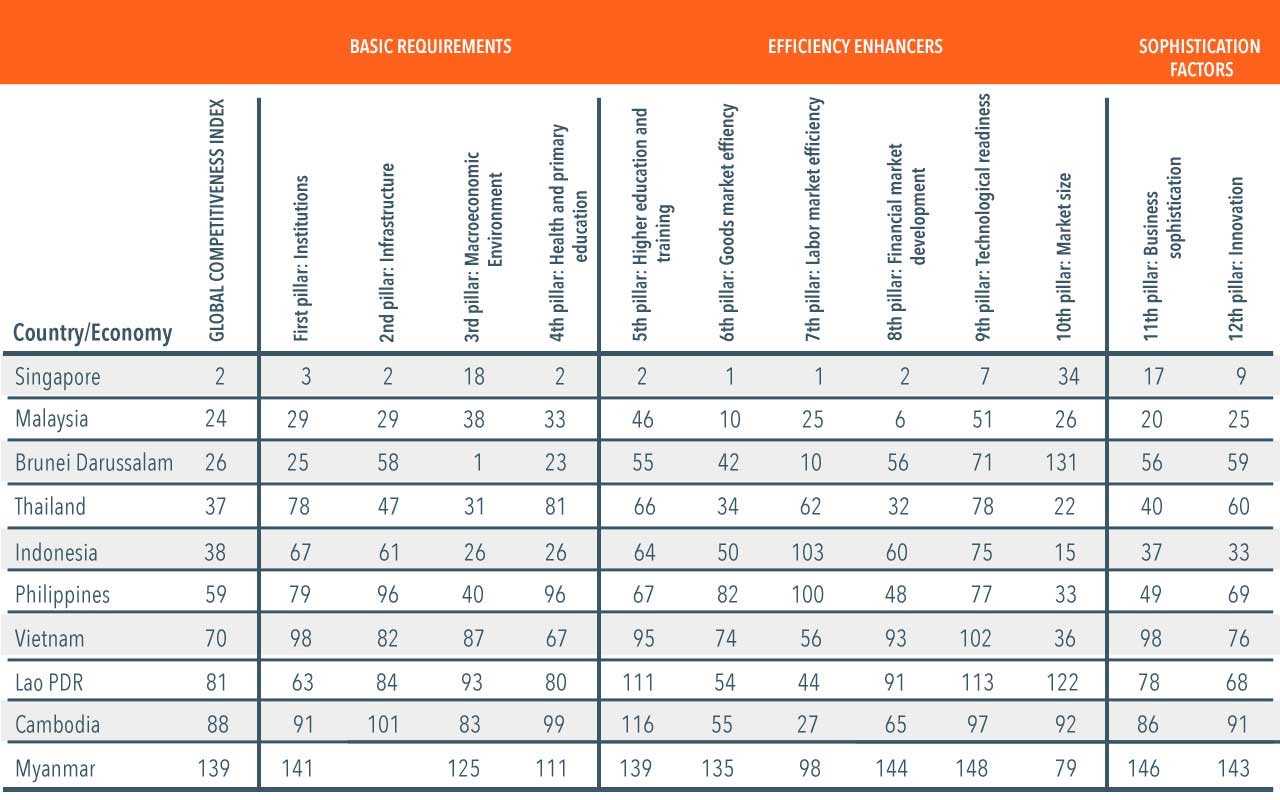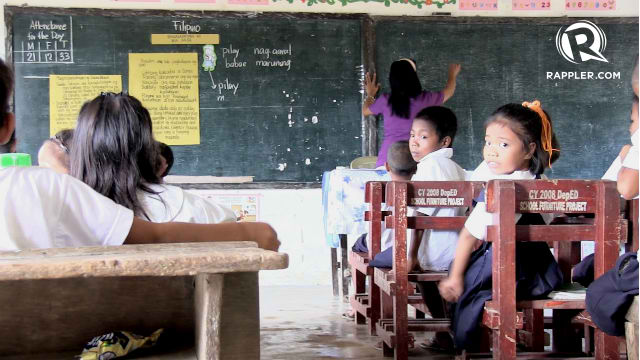SUMMARY
This is AI generated summarization, which may have errors. For context, always refer to the full article.

MANILA, Philippines – In terms of primary education and health, the Philippines is the 3rd least competitive among 10 Southeast Asian countries, according to the 2013-2014 World Economic Forum (WEF) Global Competitiveness report.
Out of 148 countries worldwide, the Philippines climbed two notches since 2012, ranking 96th. However, this is still a far leap from neighbors Singapore (2nd), Brunei (23rd), and Malaysia (33rd) which fared well.
Among Southeast Asian countries, the Philippines rated only slightly better than Cambodia (99th) and Myanmar (111th).

Although the country’s overall competitiveness index improved, health and education pillars remained poor.
These numbers may hint where Filipino children stand in the global arena – at the bottom row, behind better-nourished, better-educated, and better-funded Asian neighbors.
Exclusive economic miracle?
The Philippines, Indonesia, Malaysia, and Thailand have been hailed as Asia’s “Tiger Cub Economies” – an emerging yet more modest version of the 4 Asian tigers (South Korea, Taiwan, Singapore, Hong Kong).
The Philippines boasted of a 7.2% GDP (Gross Domestic Product) growth in 2013; second only to China in the Asian economic rat race. But does this so-called “economic miracle” reach the poor and vulnerable?
The latest Social Weather Stations (SWS) survey revealed that more families were poor and hungry at the end of 2013. The most recent National Nutrition Survey also showed that as of 2011, undernutrition continues to be a problem among schoolchildren.
The 2012 National Achievement Test results demonstrated the impact of undernutrition and ineffective learning on children – poor school performance – as reflected in the low mean percentage scores of primary and secondary school students.
These figures tell a darker tale of regular Filipinos untouched by the economic miracle.
Underinvestment in education, health
Government spending on education as of 2013 was only 2.5% of GDP, according to the Department of Education (DepEd). This does not meet the 6% recommendation of the United Nations Educational, Scientific and Cultural Organization (Unesco).
This also pales in comparison to the other tiger cub economies:
|
|
Year |
% of GDP |
|
Malaysia |
2010 |
5.1% |
|
Indonesia |
2011 |
2.8% |
|
Thailand |
2011 |
5.8% |
(Source: World Bank)
The current percentage is a big drop from the 4.2% allotment in 1998.
The same problems can be observed every school year: lack of classrooms, textbooks, teachers, funding and resources; and the soaring number of malnourished and underperforming students.
A 2013 World Bank report said that the Philippines spends only $110 (P4,975) per student per year (using prices from year 2000).
This is lower compared to other Asian countries in 2009:
|
|
Per student, per year (as of 2009) |
|
Thailand |
$853 (P38,372) |
|
Singapore |
$1,800 (P80,973) |
|
Japan |
$5,000 (P224,925) |
(Source: 2009 New York Times report citing a World Bank report. Note: Peso-dollar exchange rate is based on current rates)
In terms of spending on health, the latest available World Health Organization (WHO) data showed that as of 2011, the Philippines spent only 4.1% of GDP on health itself. This is the same as Thailand and higher than Malaysia (3.8%) and Indonesia (2.7%), but lower than Vietnam (6.8%) and Cambodia (5.7%).
These financial constraints are manifested in the dire conditions of government hospitals – the lack of services, facilities, and staff; and the looming threat of either privatization or relocation for others like the Philippine Orthopedic Center, Philippine Children’s Medical Center, and the Dr Jose Fabella Memorial Hospital.
The World Bank emphasized the problem of underinvestment in the Philippines, pointing out “the country’s public education and health systems remain underfunded and have held back the development of the country’s labor force.”
Unesco said that improving education can also improve health, as well as socioeconomic status and quality of life. The same may also be true vice-versa.
The World Bank recommended accelerating commitments and investments in health, education, and infrastructure to “create an environment conducive to increasing productivity and competitiveness.”
Bigger budget, better school year?

For 2014, education received P309.43 billion – the biggest budget allocation among all national government agencies. This is slightly higher than 2013’s P293.32 billion.
The Department of Budget Management (DBM) said that this is among the government’s initiatives to improve the public education system and build student capacities. Hopefully this will translate to more enrollees and graduates.
The Philippines is the 5th country in the world with the highest school drop-out rates. But with DepEd’s bigger funding in 2014, can we expect a better school year ahead, given that completion and drop-out rates among primary and secondary schools barely improved in the past 5 years?
| Drop-out rate | ||
|---|---|---|
| 2008-2009 | 2011-2012 | |
| Primary schools | 6.02% | 6.38% |
| Secondary schools | 7.45% | 7.82% |
| Completion rate | ||
|---|---|---|
| 2008-2009 | 2012-2013 | |
| Primary schools | 73.28% | 73.67% |
| Secondary schools | 75.24% | 74.81% |
Source: DepEd
Meanwhile, the Pantawid Pamilyang Pilipino Program (4Ps) of the Department of Social Welfare and Development (DSWD) received P62.6 billion for 2014. The program aims to improve children’s health and school attendance by providing incentives – families can receive cash grants only if they allow their children to go to school and have regular health check-ups. This year 4Ps will even expand its coverage to high school students.
2014 starts off on the right foot with bigger budget allocations for education and health. However the impact of a bigger budget will depend on whether it is used efficiently.
In 2015, we are expected to accomplish the UN Millennium Development Goals (MDGs) of alleviating hunger and improving health and education.
WHO stresses that the causes of malnutrition are related to inadequate dietary intake, but this may also be linked to the lack of access to health services and proper education.
Hunger and poverty – of resources and of knowledge – are closely intertwined. Experts have repeatedly said that health and education are both important in ensuring a good future for the country. It’s about time more people listened. – Rappler.com
Add a comment
How does this make you feel?
There are no comments yet. Add your comment to start the conversation.